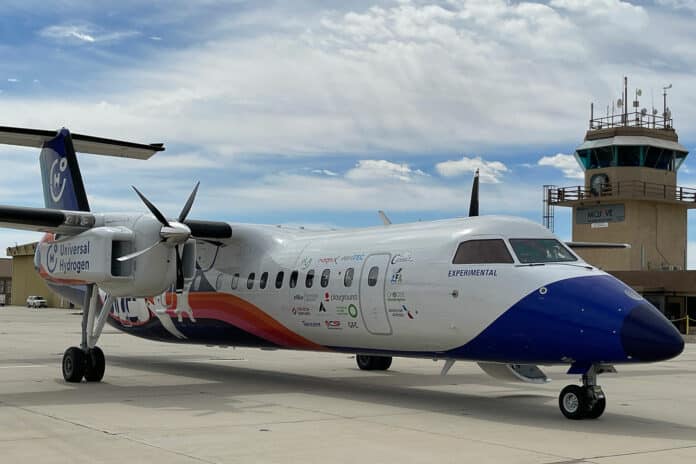Sustainable aviation is the goal of the aviation industry today. There is increasing interest in achieving carbon-neutral flights to combat global warming and climate change. Alongside SAF (Sustainable Aviation Fuel), hydrogen retrofitting is seen as one of the fastest and most effective ways to reduce the pollution of existing fleets.
ZeroAvia may be the main name associated with large-scale hydrogen projects in aviation, but California-based Universal Hydrogen isn’t far behind. Like ZeroAvia, Universal Hydrogen’s vision is to extend its modular hydrogen fueling system to single-aisle passenger planes. They are not developing new aircraft from scratch but developing a certified powertrain conversion kit to retrofit existing regional aircraft to fly on hydrogen.
Universal Hydrogen is currently in the middle of its two-year flight test campaign, expected to culminate in 2025. After successfully flying a De Havilland Dash 8 turboprop retrofitted with a hydrogen fuel cell propulsion system in Washington state, the aviation company has now relocated its flight-testing activities to the Mojave desert in Southern California. It also announced the successful ferry flight to Mojave of its Dash-8 modified 40-passenger regional airliner, powered on one side by a hydrogen fuel cell powertrain.
Since its initial successful flight test earlier this year, Universal Hydrogen has achieved four subsequent test flights, maintaining its planned trajectory for its extensive flight-testing regimen. During its second flight, the converted aircraft managed to fly for 30 minutes at 170 knots of indicated airspeed (KIAS), ascending to 5,000 feet. In the third and fourth flight tests, the aircraft reached altitudes of 10,000 feet.
During the most recent flight in Moses Lake, Washington, its Dash-8 testbed, “Lightning McClean,” traveled down the west coast with four stops across Oregon and California. The aircraft covered a distance of over 800 nautical miles before reaching Mojave. The aircraft will reside at the Mojave Air & Space Port in California, where Universal Hydrogen will conduct additional test flights gearing up for its goal of commercial entry into service in late 2025.
The company explained the hydrogen powertrain was fully utilized for each takeoff, and on the first three legs of the ferry, it was throttled down after takeoff. During the final flight segment, the hydrogen fuel cell powertrain was used for the duration of the entire flight, accruing over 180 nautical miles and a flight time of over one hour, which is the longest flight by a hydrogen fuel cell powertrain to date.
“In our relentless pursuit to decarbonize aviation, moving our flight testing to Mojave brings us closer to our headquarters in Hawthorne, ensuring optimal coordination with the team,” says Mark Cousin, CTO of Universal Hydrogen. “We extend our gratitude to Washington state and specifically Moses Lake for their invaluable support as we began our historic test flights with the largest hydrogen fuel cell-powered aircraft. Our calculated testing strategy guarantees the safety of our converted aircraft, propelling us towards our goal to have it in service within the next two years.”
